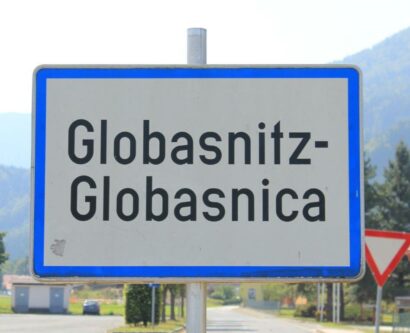The Slovene Minority in Austria
The Slovene ethnic group is an “autochthonous” (“old-established”) minority. The traditional settlement area is in southern Carinthia. It stretches along the border to Italy and Slovenia and essentially comprises the lower Gailtal, the Jauntal and the Rosental. No precise statement can be made about the size of the ethnic group. Data from censuses are problematic: they require a profession to the minority. The influence of the political and social climate must not be disregarded when evaluating the results.
 Coexistence became “politicised” with the rise of nationalism from the middle of the 19th century: now a national camp formation began on the “German” and “Slovene” side. At the end of the First World War, the Kingdom of Serbs, Croats and Slovenes (SHS) laid claim to parts of southern Carinthia. This was followed by a military conflict (“Kärntner Abwehrkampf”) and a Carinthian referendum – mediated by international intervention – on 10 October 1920, which was decided in favour of Austria with a considerable proportion of Slovenian votes. Contrary to the promises made to the Carinthian Slovenes by the Carinthian provincial assembly before the referendum to preserve their “national character”, a targeted “Germanisation” takes place.
Coexistence became “politicised” with the rise of nationalism from the middle of the 19th century: now a national camp formation began on the “German” and “Slovene” side. At the end of the First World War, the Kingdom of Serbs, Croats and Slovenes (SHS) laid claim to parts of southern Carinthia. This was followed by a military conflict (“Kärntner Abwehrkampf”) and a Carinthian referendum – mediated by international intervention – on 10 October 1920, which was decided in favour of Austria with a considerable proportion of Slovenian votes. Contrary to the promises made to the Carinthian Slovenes by the Carinthian provincial assembly before the referendum to preserve their “national character”, a targeted “Germanisation” takes place.
The expulsion of thousands of members of the ethnic group during the National Socialist era and the resistance of the Slovene partisans against the Nazi regime lead to attacks on the civilian population on both sides.
As a result of Yugoslavia’s territorial claims to parts of southern Carinthia after World War II, the minority rights of the Slovenes and Croats are enshrined in Article 7 of the Austrian State Treaty of 1955. The Second Republic was dominated by disputes over bilingual education and bilingual place-name signs, which culminated in the “Ortstafelsturm” in the 1970s, until an agreement was reached in 2011 to settle the place-name sign issue at constitutional level.
The Slovene ethnic group is protected by rights at the level of international law, constitutional law and simple law (e.g. in the Ethnic Groups Act, in the State Treaties of St. Germain 1920 and Vienna 1955, the European Charter for the Protection of Regional and Minority Languages or the European Framework Convention for the Protection of National Minorities). These rights include, among others, the right to education in the minority language, use of Slovene before authorities and courts or bilingual topographical signs in certain areas. The implementation of these rights in practice has repeatedly led to disputes.
Current challenges for the ethnic group are emigration and assimilation. This can be seen in the decline of the Slovene language in the 20th century: If at the beginning of the century about one third of the population in Carinthia still reported Slovene as their colloquial language, by the end it was only slightly more than 2%. With the accession to the EU and the increasing importance of foreign language skills, the previously often negative image of the Slovene language in Carinthia has also changed. Today it is attractive to learn Slovene in Carinthia.
The Council of Carinthian Slovenes (Narodni svet koroških Slovencev, NSKS), the Community of Carinthian Slovenes (Skupnost koroških Slovencev in Slovenk, SKS), the Central Association of Slovenian Organisations (Zveza slovenskih organizacij na Koroškem, ZSO), the Unity List/Enotna Lista (EL) are committed to the political concerns of the ethnic group in Carinthia.